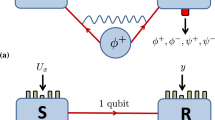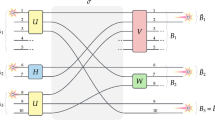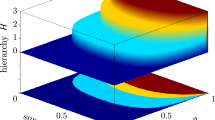Abstract
Entanglement is one of the most puzzling features of quantum theory and of great importance for the new field of quantum information. Being a peculiar form of entanglement, bound entanglement emerges in certain mixed quantum states. This form of entanglement is not distillable by local operators and classical communication. Bound-entangled states are different from both the free entangled (distillable) and separable states. Here we report on the first experimental demonstration of a four-qubit polarization bound-entangled state, the so-called Smolin state. We have fully characterized its entanglement properties. Moreover, we have realized unlocking of the entanglement protocol for this state. The special properties of the Smolin state constitute a useful quantum resource for new multiparty communication schemes.
This is a preview of subscription content, access via your institution
Access options
Subscribe to this journal
Receive 12 print issues and online access
$209.00 per year
only $17.42 per issue
Buy this article
- Purchase on Springer Link
- Instant access to full article PDF
Prices may be subject to local taxes which are calculated during checkout





Similar content being viewed by others
References
Einstein, A., Podolsky, B. & Rosen, N. Can quantum-mechanical description of physical reality be considered complete? Phys. Rev. 47, 777–780 (1935).
Bell, J. S. On the Einstein–Podolsky–Rosen paradox. Physics 1, 195–200 (1964).
Peres, A. Separability criterion for density matrices. Phys. Rev. Lett. 77, 1413–1415 (1996).
Horodecki, M., Horodecki, P. & Horodecki, R. Separability of mixed states: Necessary and sufficient conditions. Phys. Lett. A 223, 1–8 (1996).
Zurek, W. H. Decoherence and the transition from quantum to classical. Phys. Today 44, 36–44 (1991).
Horodecki, M., Horodecki, P. & Horodecki, R. Inseparable two spin-(1/2) density matrices can be distilled to a singlet form. Phys. Rev. Lett. 78, 574–577 (1997).
Bennett, C. H. et al. Purification of noisy entanglement and faithful teleportation via noisy channels. Phys. Rev. Lett. 76, 722–725 (1996).
Horodecki, P. Separability criterion and inseparability mixed states with positive partial transposition. Phys. Lett. A 232, 333–339 (1997).
Horodecki, M., Horodecki, P. & Horodecki, R. Mixed-state entanglement and distillation: Is there a bound entanglement in nature? Phys. Rev. Lett. 80, 5239–5242 (1998).
Tóth, G., Knapp, Ch., Gühne, O. & Briegel, H. J. Optimal spin squeezing inequalities detect bound entanglement in spin models. Phys. Rev. Lett. 99, 250405 (2007).
Ferraro, A., Cavalcanti, D., Garía-Saez, A. & Acin, A. Thermal bound entanglement in macroscopic systems and area law. Phys. Rev. Lett. 100, 080502 (2008).
Acin, A., Cirac, J. I. & Masanes, Li. Multipartite bound information exists and can be activated. Phys. Rev. Lett. 92, 107903 (2004).
Smolin, J. A. Four-party unlockable bound entangled state. Phys. Rev. A 63, 032306 (2001).
Shor, P. W., Smolin, J. A. & Thapliyal, A. V. Superactivation of bound entanglement. Phys. Rev. Lett. 90, 107901 (2003).
Augusiak, R. & Horodecki, P. Generalized Smolin state and their properties. Phys. Rev. A 73, 012318 (2006).
Murao, M. & Vedral, V. Remote information concentration using a bound entangled state. Phys. Rev. Lett. 86, 352–355 (2001).
Augusiak, R. & Horodecki, P. Bound entanglement maximally violating Bell inequalities: Quantum entanglement is not full equivalent to cryptographic security. Phys. Rev. A 74, 010305 (2006).
Brukner, Č., Zukowski, M., Pan, J.-W. & Zeilinger, A. Bell’s inequalities and quantum communication complexity. Phys. Rev. Lett. 92, 127901 (2004).
Wang, G. & Ying, M. Multipartite unlockable bound entanglement in the stabilizer formalism. Phys. Rev. A 75, 052332 (2007).
Kwiat, P. G. et al. New high intensity source of polarization-entangled photon pairs. Phys. Rev. Lett. 75, 4337–4341 (1995).
James, D. F., Kwiat, P. G., Munro, W. J. & White, A. Measurement of qubits. Phys. Rev. A 64, 052312 (2001).
Tóth, G. & Gühne, O. Entanglement detection in stabilizer formalism. Phys. Rev. A 72, 022340 (2005).
Braunstein, S. L., Mann, A. & Revzen, M. Maximal violation of Bell inequalities for mixed states. Phys. Rev. Lett. 68, 3259–3261 (1992).
Kiesel, N. et al. Linear optics controlled-phase gate made simple. Phys. Rev. Lett. 95, 210505 (2005).
Lewenstein, M., Kraus, B., Cirac, J. I. & Horodecki, P. Optimization of entanglement witnesses. Phys. Rev. A 62, 052310 (2000).
Gühne, O. et al. Detection of entanglement with few local measurements. Phys. Rev. A 66, 062305 (2002).
Tóth, G. QUBIT4MATLAB V3.0: A program package for quantum information science and quantum optics for MATLAB. Comput. Phys. Commun. 179, 430–437 (2008).
Acknowledgements
We acknowledge support by the Swedish Research Council (Vetenskapsrådet).
Author information
Authors and Affiliations
Contributions
E.A. carried out the experiment. E.A. and M.B. discussed the results and wrote the manuscript. M.B. supervised the project.
Corresponding author
Rights and permissions
About this article
Cite this article
Amselem, E., Bourennane, M. Experimental four-qubit bound entanglement. Nature Phys 5, 748–752 (2009). https://doi.org/10.1038/nphys1372
Received:
Accepted:
Published:
Issue Date:
DOI: https://doi.org/10.1038/nphys1372
This article is cited by
-
Comparative Dynamical Study of a Bound Entangled State
International Journal of Theoretical Physics (2022)
-
Efficacy of Moriya interaction to free the bound entangled state
Quantum Information Processing (2022)
-
Mirrored entanglement witnesses
npj Quantum Information (2020)
-
Work and heat value of bound entanglement
Quantum Information Processing (2019)
-
Rational quantum secret sharing
Scientific Reports (2018)



